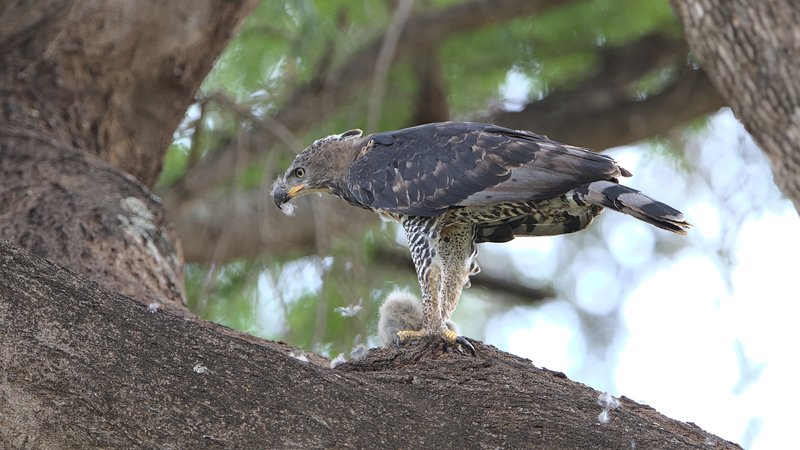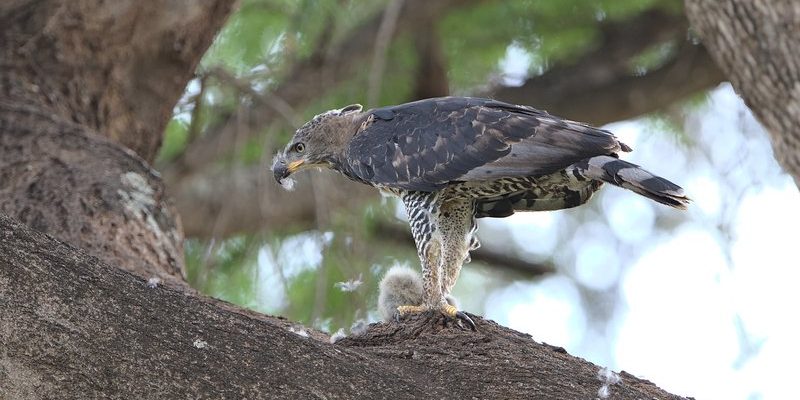
So, what makes the crowned eagle stand out among its feathered friends? Well, for starters, it’s not just about their regal name or stunning plumage. There’s a whole world of fascinating traits and behaviors that make these birds remarkable. Whether you’re a birdwatcher, a nature lover, or just curious, let’s dive into ten captivating facts about the crowned eagle and explore what makes this bird so extraordinary.
1. The Scientific Name: A Closer Look
The crowned eagle is scientifically known as *Stephanoaetus coronatus*. This name hints at its impressive features. The genus name, *Stephanoaetus*, comes from Greek, meaning “crowned eagle.” This might sound fancy, but it highlights the bird’s distinctive crown of feathers on its head, which adds to its royal appearance.
*Strong and powerful*, the crowned eagle belongs to the Accipitridae family, which includes other eagles, hawks, and kites. You might be wondering, what sets it apart from other eagles? Well, their size is one of the first things that catches your eye. Crowned eagles are among the largest eagles in Africa, with wingspans reaching up to 2.2 meters (about 7.2 feet). That’s as long as a small car!
2. Stunning Appearance: What to Look For
Here’s the thing: the crowned eagle doesn’t just rely on size to impress. Its appearance is equally captivating. You can recognize them by their dark brown plumage, accented with striking white and chestnut patterns. The real showstopper, though, is that impressive crest of feathers on their head. It can stand tall when they’re excited or trying to intimidate other birds, adding to their majestic presence.
Another thing to note is their incredible facial structure. Crowned eagles have strong, hooked beaks that help them tear through flesh—perfect for their predatory lifestyle. Their sharp talons are designed for gripping prey tightly. You really wouldn’t want to be on the receiving end of those claws!
3. Habitat: Where They Call Home
Crowned eagles typically inhabit wooded areas, including tropical rainforests and savannas across Sub-Saharan Africa. You might find them in regions like the Congo Basin or parts of East Africa. These birds prefer locations that provide plenty of tall trees for nesting and perching, giving them the perfect vantage point to scout for food.
Honestly, their habitat impacts their behavior significantly. For instance, they’re less likely to be found in open areas like grasslands, where they can’t easily spot their prey. Instead, they thrive in dense forests, where their keen eyesight and stealth can work to their advantage.
4. Diet: The Crowned Eagle’s Menu
So, what do crowned eagles eat? These apex predators have a diverse diet, feasting mainly on small to medium-sized mammals and birds. They’re particularly fond of monkeys, rodents, and even small antelopes—impressive for a bird, right?
Their hunting style is fascinating, too. Crowned eagles are known to be ambush hunters. They’ll quietly perch high in a tree, scanning the ground below until they spot their meal. Then, with breathtaking speed and precision, they swoop down to capture their prey. Imagine a fighter jet diving to the ground. It’s a swift and graceful act that’s both thrilling and a little bit intimidating.
5. Nesting and Breeding: Raising Their Young
Crowned eagles are monogamous, meaning they typically mate for life. During the breeding season, they build large nests in tall trees, often using sticks, leaves, and other materials found in their surroundings. These nests can be impressively big—some measure over 1 meter in diameter!
When it comes to raising young, crowned eagles usually lay one to three eggs at a time. The female incubates the eggs for about 45 days, while the male takes charge of hunting and bringing food to the nest. Once the chicks hatch, they rely on their parents for several months before becoming independent. This period is crucial for their survival, as they learn everything from hunting techniques to navigating their jungle home.
6. Their Role in The Ecosystem
Crowned eagles play a vital role in their ecosystems. As top predators, they help to control populations of various animals, maintaining a balance within their habitats. By preying on smaller mammals and birds, they prevent those populations from exploding, which can disrupt the food chain and the overall health of the environment.
You might find it interesting that crowned eagles are considered indicators of a healthy ecosystem. When their populations thrive, it often means the environment is in good shape. However, changes in their habitats—like deforestation or human encroachment—can affect their numbers. Conservation efforts are crucial for ensuring these magnificent birds continue to soar through the skies.
7. Cultural Significance: A Bird of Reverence
Across various cultures in Africa, the crowned eagle holds significant symbolism. Many tribes view it as a symbol of power, strength, and courage. In some places, its image is used in traditional art and stories, showcasing its prominence in local lore.
Additionally, the crowned eagle is sometimes used as a heraldic symbol, representing nobility and valor. You can see how this majestic bird has earned its respect not just for its physical grandeur, but also for its deep-rooted connections in cultural narratives around the continent.
8. Threats and Conservation: Challenges They Face
Unfortunately, crowned eagles face numerous threats in the wild. Habitat destruction is one of the biggest challenges they encounter. As forests are cleared for agriculture and urban development, their nesting sites and hunting grounds diminish. The loss of habitat puts immense pressure on their populations.
Additionally, hunting poses another threat. In some regions, they are hunted for their feathers or fear from local farmers who see them as a threat to livestock. Conservation efforts are essential to safeguard their habitats and raise awareness about their ecological role. Many organizations work to protect these birds and their environments, striving to ensure they can continue to thrive.
9. Fascinating Behaviors: More Than Just a Pretty Face
Crowned eagles are not only impressive in appearance; they exhibit fascinating behaviors, too. They have a unique courtship display where they perform aerial acrobatics, soaring high into the sky before diving with grace. It’s like a dance in the air, showcasing their strength and agility.
These birds are also known for their vocalizations, which include a range of calls that can sound quite expressive. You might hear them making a series of sharp, high-pitched whistles or deep booming sounds, especially during mating season. It’s a way for them to communicate and establish territory.
10. Where to See Crowned Eagles
If you’re eager to catch a glimpse of a crowned eagle, your best bet is to visit national parks and wildlife reserves in Sub-Saharan Africa. Places like Kruger National Park in South Africa or Akagera National Park in Rwanda are known for their rich biodiversity and opportunities to spot these stunning birds in the wild.
Birdwatching enthusiasts often recommend going during early mornings or late afternoons when crowned eagles are most active. Bring your binoculars, find a peaceful spot, and be patient. Watching one of these magnificent eagles in flight is a breathtaking experience that you’ll treasure forever.
In conclusion, the crowned eagle is more than just a bird with a fancy name; it’s a vital part of its ecosystem, a symbol of cultural heritage, and a creature of remarkable beauty and strength. As we learn more about these incredible birds, we also gain a deeper understanding of the importance of conservation and protecting their habitats. Next time you think of eagles, remember the crowned eagle and all the fascinating aspects that make it truly unique.

